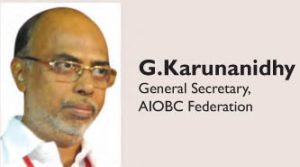 The report of the Second Commission for Backward Classes headed by B.P.Mandal was partially accepted and some of the recommendations of the Commission were implemented by Late V.P.Singh, the then Prime Minister in 1990. For the first time reservation benefits were extended to the backward classes for recruitment in Central Government and Government of India undertakings, public sector banks, insurance companies and financial development institutions. The reservation benefit was introduced as per the list of backward classes based on caste identity categorised by Central Government. The basis of discrimination is caste and naturally the compensatory discrimination i.e. reservation has to be made only on the basis of the caste identity. V.P.Singh Government implemented reservation based on that criterion. The Central Government order was challenged by Indra Sawhney, a practising lawyer by the way of a Public Interest Litigation (PIL). The earlier pronouncement of Supreme Court was that economic criterion was not constitutionally valid but in the present case of PIL, it was held differently. The Supreme Court held that though caste can be the basis for classification, the advanced section of the caste, the Creamy Layer should be excluded or removed and they cannot be given the benefit of reservation. The concept of ‘Creamy Layer’ is the concealed form of prescription of economic criterion for reservation. Even though the concept of ‘Creamy Layer’ was made applicable to all castes of Backward Classes, Scheduled Castes and Scheduled Tribes, the Government did implement only in respect of backward classes. Again it is segregating the already segregated. It has to be construed as the act favourable to the social monopolist to divide further the discriminated masses, who were denied education and employment. This is a neo mode of dividing the oppressed section with deprivation and to weaken their joint opposition against the social monopolists.
The report of the Second Commission for Backward Classes headed by B.P.Mandal was partially accepted and some of the recommendations of the Commission were implemented by Late V.P.Singh, the then Prime Minister in 1990. For the first time reservation benefits were extended to the backward classes for recruitment in Central Government and Government of India undertakings, public sector banks, insurance companies and financial development institutions. The reservation benefit was introduced as per the list of backward classes based on caste identity categorised by Central Government. The basis of discrimination is caste and naturally the compensatory discrimination i.e. reservation has to be made only on the basis of the caste identity. V.P.Singh Government implemented reservation based on that criterion. The Central Government order was challenged by Indra Sawhney, a practising lawyer by the way of a Public Interest Litigation (PIL). The earlier pronouncement of Supreme Court was that economic criterion was not constitutionally valid but in the present case of PIL, it was held differently. The Supreme Court held that though caste can be the basis for classification, the advanced section of the caste, the Creamy Layer should be excluded or removed and they cannot be given the benefit of reservation. The concept of ‘Creamy Layer’ is the concealed form of prescription of economic criterion for reservation. Even though the concept of ‘Creamy Layer’ was made applicable to all castes of Backward Classes, Scheduled Castes and Scheduled Tribes, the Government did implement only in respect of backward classes. Again it is segregating the already segregated. It has to be construed as the act favourable to the social monopolist to divide further the discriminated masses, who were denied education and employment. This is a neo mode of dividing the oppressed section with deprivation and to weaken their joint opposition against the social monopolists.
Organisations, striving for Social Justice have been opposing the very concept of creamy layer from the beginning. The Constitution speaks of socially and educationally backward classes and not economic backwardness. Article 16 (4) of the Constitution speaks about adequate representation of backward classes in services. What is not stated in Constitution is being imposed only on OBCs and the income criteria and anomalies of the guidelines of the Department of Personnel and Training, Government of India have totally affected the welfare of eligible OBCs.
Parliamentary Standing Committee on Personnel in its VIII Report submitted to Parliament in July 2005 has recommended removal of creamy layer and requested the Government to move legally to remove this concept.
The recent recommendation sent by the National Commission for the Backward Classes dated 29.1.2016 to Ministry of Social Justice and Empowerment on rationalisation of creamy layer has opened further debates and dissent. The data of representation of OBCs shows a dismal figure of OBCs in the Services of Government sectors, public sector undertakings, public sector banks and other institutions. In Central Educational Institutions, the seats created for OBCs, if not filled due to non availability of OBCs will automatically be shifted to General Category students. Why? The creamy layer concept has deprived eligible OBC students from availing the reservation. Hard won rights of the OBCs are being usurped by others.
Reservation is not a poverty alleviation scheme. The Constitution speaks of Socially and Educationally backward classes. Nowhere in the world, reservation is applied based on economic criteria except in India and that too against Other Backward Classes.
The Government must bring Constitutional amendment and remove the creamy layer concept imposed on OBCs.




